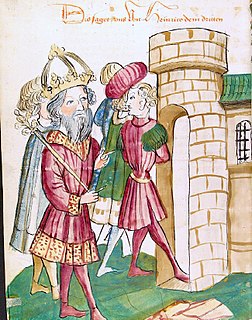This article includes a list of references, related reading or external links, but its sources remain unclear because it lacks inline citations .(November 2018) (Learn how and when to remove this template message) |
Pandulf V was the count of Teano and prince of Capua (1022–1026). That he was related to the ruling dynasty of Capua seems likely, but is uncertain. He was installed at Capua by Pilgrim, Archbishop of Cologne, who besieged Capua and deposed the current prince, Pandulf IV was imprisoned in Germany. The Emperor Henry II officially granted the principality to Pandulf V in 1023 and associated his son John with him as co-prince.

Teano is a town and comune in the province of Caserta, Campania, southern Italy, 30 kilometres (19 mi) northwest of Caserta on the main line to Rome from Naples. It stands at the southeast foot of an extinct volcano, Rocca Monfina. Its St. Clement's cathedral is the see of the Roman Catholic Diocese of Teano-Calvi, which started as Diocese of Teano circa AD 300.

Pandulf IV was the Prince of Capua on three separate occasions.
In 1024, at the behest of Guaimar III of Salerno, Emperor Conrad II released Pandulf IV. Guaimar and Pandulf promptly besieged Capua with the help of the Norman mercenary Rainulf Drengott. In 1025, the Byzantine catapan Basil Boiannes, who had been busy on a Sicilian expedition, joined them with a giant force. In 1026, after an 18-month siege, Boiannes negotiated Pandulf V's surrender and granted him and his son John safe conduct to Naples.
Guaimar III was the Lombard prince of Salerno from around 994 to his death. Under his reign, Salerno entered an era of great splendour. Opulenta Salernum was the inscription on his coins. He made Amalfi, Gaeta and Sorrento his vassals and annexed much of Byzantine Apulia and Calabria.

The Byzantine Empire, also referred to as the Eastern Roman Empire or Byzantium, was the continuation of the Roman Empire in its eastern provinces during Late Antiquity and the Middle Ages, when its capital city was Constantinople. It survived the fragmentation and fall of the Western Roman Empire in the 5th century AD and continued to exist for an additional thousand years until it fell to the Ottoman Turks in 1453. During most of its existence, the empire was the most powerful economic, cultural, and military force in Europe. Both the terms "Byzantine Empire" and "Eastern Roman Empire" are historiographical terms created after the end of the realm; its citizens continued to refer to their empire simply as the Roman Empire, or Romania (Ῥωμανία), and to themselves as "Romans".

Naples is a major city in southern Italy. It is the capital of the Campania region, and the third-largest municipality in Italy after Rome and Milan. The city is called Napoli in Italian, and Napule in Neapolitan. The name comes from Ancient Greek Νεάπολις, meaning "new city", via the Latin Neapolis.
In 1027, Pandulf IV, now reinstated, besieged Sergius IV of Naples, who had offered haven to Pandulf of Teano. The city fell and Sergius went into hiding. Pandulf and his son fled to either Rome or "Romania", where he died some years later. John was dead by 1052, when his younger brother Pandulf appears as the "firstborn" among his brothers.

Sergius IV was Duke of Naples from 1002 to 1036. He was one of the prime catalysts in the growth of Norman power in the Mezzogiorno in the first half of the eleventh century. He was nominally a Byzantine vassal, like his father, John IV, before him.

Rome is the capital city and a special comune of Italy. Rome also serves as the capital of the Lazio region. With 2,872,800 residents in 1,285 km2 (496.1 sq mi), it is also the country's most populated comune. It is the fourth most populous city in the European Union by population within city limits. It is the centre of the Metropolitan City of Rome, which has a population of 4,355,725 residents, thus making it the most populous metropolitan city in Italy. Rome is located in the central-western portion of the Italian Peninsula, within Lazio (Latium), along the shores of the Tiber. The Vatican City is an independent country inside the city boundaries of Rome, the only existing example of a country within a city: for this reason Rome has been often defined as capital of two states.





